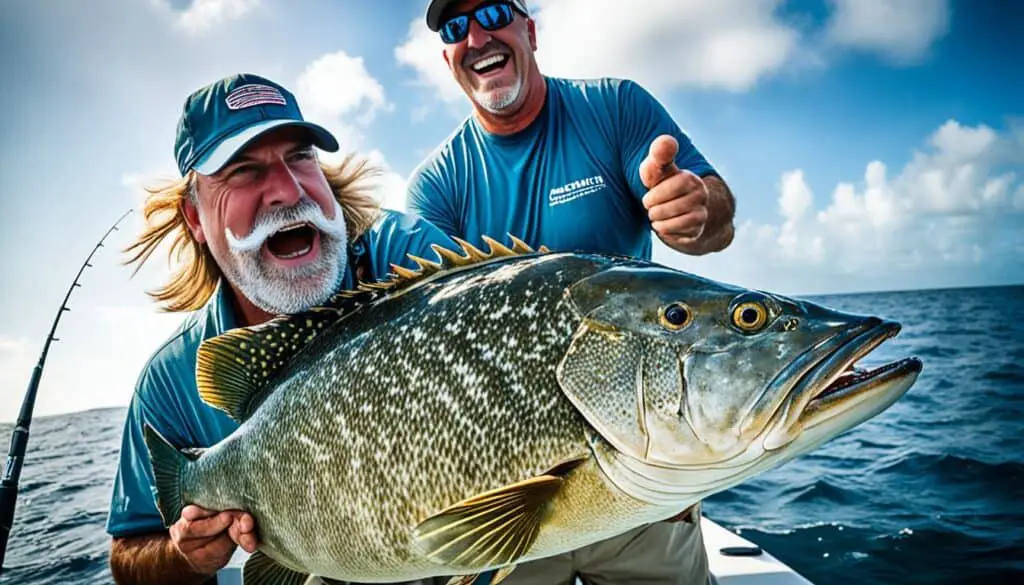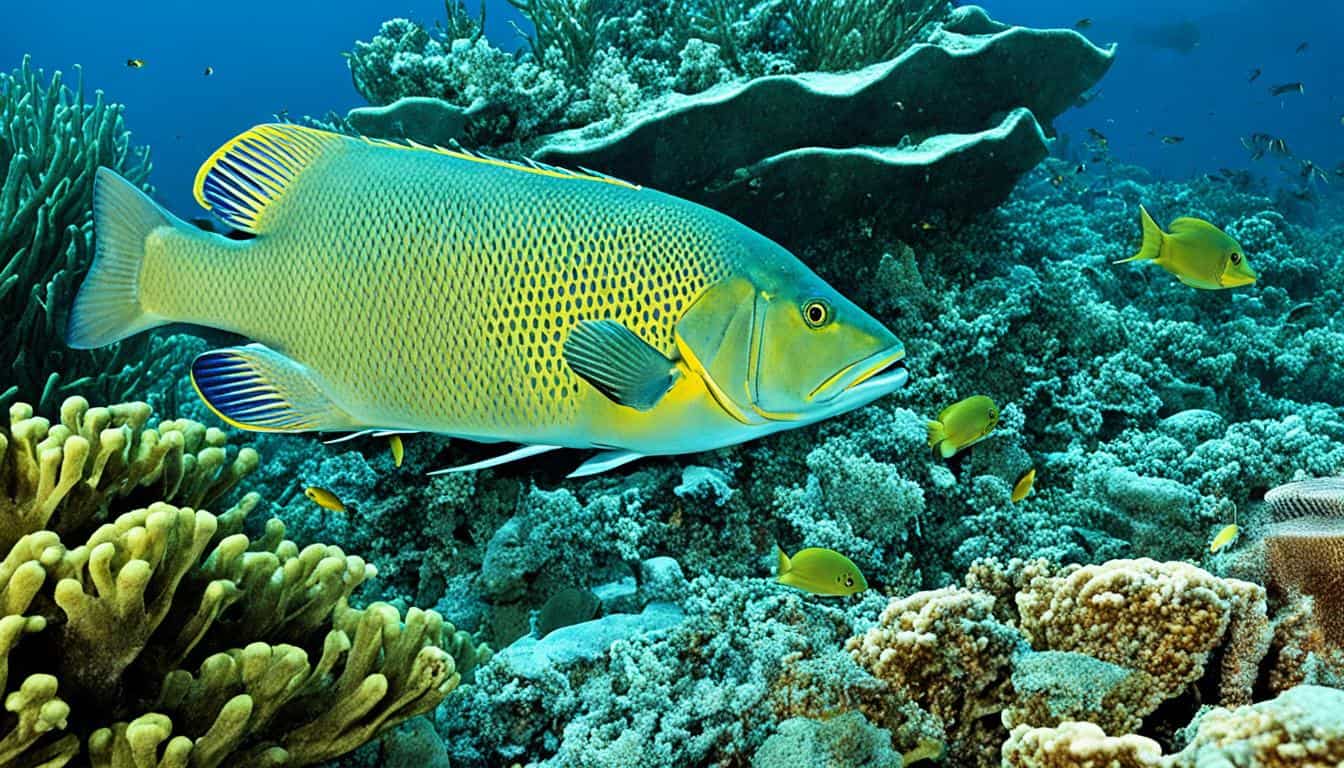Are you wondering, “How big do groupers get?” You’re not the only one. Groupers are a fascinating family of fish known for their large mouths and heavy bodies. They belong to the Serranidae family. These fish come in many sizes and colors, from the small Nassau grouper to the huge goliath grouper.
Knowing how big groupers can get is important for fishermen and those who love the sea. It helps them understand the underwater world better. Groupers are interesting because of their growth potential and the variety in their sizes.
They can grow to different lengths and weights, depending on the species. If you’re planning a fishing trip or just want to learn more, knowing about grouper sizes is useful. It can deepen your understanding of these amazing fish.
Introduction to Groupers
Groupers are fascinating marine fish that belong to the genera Epinephelus and Mycteroperca. There are over 100 grouper species, each with unique traits. These fish stand out in their habitats because of their distinct characteristics.
What are Groupers?
Groupers are known for their big bodies and large mouths. They can grow to different sizes. These fish live in warm ocean waters and often have dull colors. Some have bright patterns that help them blend in with their surroundings.
They are strong and play a key role as top predators in their ecosystems.
Distribution of Groupers
Groupers live in the Atlantic and Indo-Pacific regions. They like coral reefs and deep ocean areas. This wide range helps them live in diverse marine ecosystems.
They adapt their behaviors and physical traits to fit different environments.
https://www.youtube.com/watch?v=6Wel7fBzaYA
Learning about groupers helps us understand their role in the ocean. We see how they adapt and interact in various marine settings.
How big do groupers get?
Groupers come in all sizes, from small to very large. They vary in length and weight. This is important for fishermen and those who care about the ocean.
Size Variability Among Species
Groupers differ greatly in size. Some are small, while others can be huge. Knowing this helps us understand where they live and thrive.
Largest Grouper Species
The goliath grouper is the biggest, reaching up to 8 feet long and weighing about 800 pounds. This shows just how big some groupers can get.
Average Grouper Length and Weight
Groupers come in various sizes. Smaller ones, like the Nassau grouper, are about 3 feet long and weigh 40 pounds. The black grouper is bigger, reaching 7.5 feet and weighing up to 440 pounds. Knowing these sizes is key for fishing rules and protecting these fish.

| Species | Average Length | Weight Range |
|---|---|---|
| Goliath Grouper | Up to 8 feet | Up to 800 pounds |
| Black Grouper | About 7.5 feet | Up to 440 pounds |
| Nassau Grouper | Around 3 feet | About 40 pounds |
Growth Rate of Groupers
The growth rate of groupers is key to understanding their life cycle and their role in the ecosystem. Different species of groupers have varying developmental stages, affecting how fast they grow and mature. Knowing these stages helps us understand their growth patterns and behaviors.
Development Stages
Groupers go through several developmental stages in their life. They start as larvae in safe places like mangroves or estuaries, away from predators. As they grow, they move to reefs or rocky areas for food and space.
Factors Affecting Growth Rate
Many factors affect how fast groupers grow. Things like water temperature, salinity, and the quality of their habitat matter a lot. Also, how much food they get is crucial. They need a diet full of nutrients to grow quickly.
Predators can also slow down their growth, especially for young groupers. Interestingly, female groupers usually get bigger before they mature than males. This shows how different groupers can grow at different rates.
Varieties of Groupers and Their Sizes
Groupers come in many species, each with its own size and traits. Knowing about these fish helps us understand their lives in the ocean. We’ll look at some well-known groupers and compare their sizes to show how different they are.
Notable Grouper Species
Some grouper species stand out because of their size and role in the ocean. Here are a few:
- Goliath Grouper – It can get really big, over 800 pounds.
- Warsaw Grouper – This fish can be as long as 7.5 feet.
- Black Grouper – It weighs about 400 pounds and is loved by fishermen.
- Rock Hind – This grouper is smaller, reaching only 2 feet in length.
Size Comparison Among Species
Looking at grouper sizes shows how different they can be. Here’s a table that compares some groupers:
| Grouper Species | Maximum Weight (lbs) | Maximum Length (feet) |
|---|---|---|
| Goliath Grouper | 800 | 10 |
| Warsaw Grouper | 500 | 7.5 |
| Black Grouper | 400 | 5.5 |
| Rock Hind | 15 | 2 |
This comparison shows the wide range of sizes among groupers. It highlights their diversity and the need to protect them.
Implications for Fishing and Conservation
Groupers are key to marine ecosystems. They help keep coral reefs balanced and support local fishing. Their big sizes, like the goliath grouper, make us worry about their future. To help, fishing rules have been set to protect them and keep marine life healthy.
Groupers are easily overfished because they are big predators. Many places have made rules to stop their numbers from dropping too low. These rules help protect groupers and keep the oceans healthy.
It’s important to fish sustainably so future generations can enjoy groupers and their homes. Fishermen need to know about local fishing laws and conservation plans. By fishing responsibly, you help protect these amazing fish and the ecosystems they live in.
FAQ
How big do groupers get?
Groupers come in all sizes. The goliath grouper can be up to 8 feet long and weigh about 800 pounds. Smaller ones, like the Nassau grouper, are around 3 feet long and weigh about 40 pounds.
What is the largest grouper species?
The biggest grouper is the goliath grouper. It can grow up to 8 feet long and weigh nearly 800 pounds. This makes it a big interest for fishermen and divers.
What is the average grouper length?
Groupers vary in size. The Nassau grouper is about 3 feet long. But, the black grouper can grow up to 7.5 feet long.
What is the weight range of groupers?
Groupers can weigh a lot or a little. The rock hind is small, weighing just a few pounds. But, the goliath grouper can weigh up to 800 pounds.
How fast do groupers grow?
Groupers grow at different rates. The goliath grouper grows fast when it’s young. How much it grows depends on the food it gets.
At what age do groupers reach maturity?
Groupers mature at different ages and sizes. Females usually get bigger and mature later than males. This varies by species and environment.
What notable species of groupers are there?
Some well-known groupers are the goliath grouper, Nassau grouper, black grouper, and Warsaw grouper. Each has its own size and traits, showing the variety in this group.
How do grouper sizes compare among species?
Groupers come in many sizes. The rock hind is the smallest, up to 2 feet. The goliath grouper is the biggest, showing the wide range in grouper sizes. Knowing these sizes helps with conservation and fishing rules.
Why are fishing regulations important for groupers?
Fishing rules are key for protecting groupers, especially big ones like the goliath grouper. They prevent overfishing. This keeps the fish populations healthy and the fishing sustainable.







